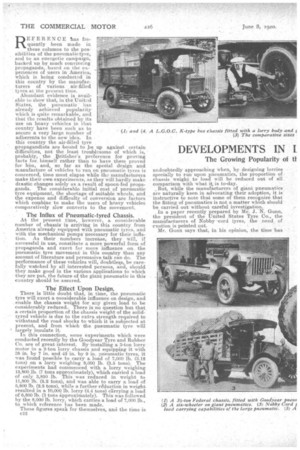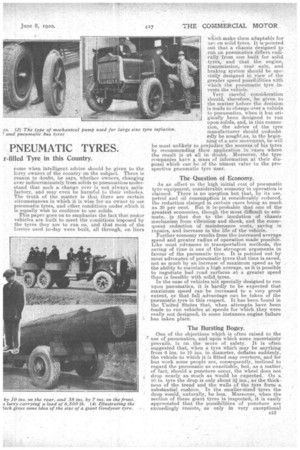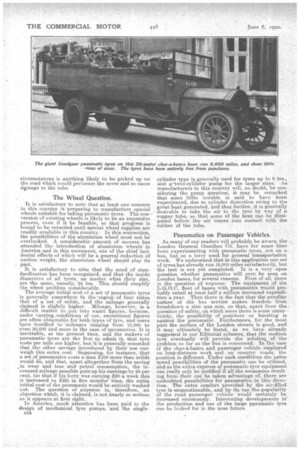DEVELOPMENTS IN I PNEUMATIC TYRES.
Page 10

Page 11

Page 12

If you've noticed an error in this article please click here to report it so we can fix it.
The Growing Popularity of ti
.r-filled Tyre. in this Country, REFERENCE tas frequently been made in these columns to the possibilities of the pneuinatic tyre,. and to an energetic campaign, backed up by much convincing propaganda; based on the experiences of users in Aineriea., which is being conducted in this country by the manufacturers of various air-filled tyres at the present time.
Abundant evidence is 'available to show that, in the United States, the pneumatic " has already achieved popularity which is quite remarkable, and that the reaults obtained by its use on heavy vehicles in that country have been such as to secure a very large number of adherents to the new idea. In this country the air-filled tyre propagandists are bound to he up against certain difficulties, not the least troublesome of which is, probably, the Dritisher's preference for proving facts for, himself rather than to have them proved for him, and, -so far as the speaial design and manufacture of vehicles to 'run on pneumatic tyres is concerned, time must elapse while the manufacturers make their OWE experiments, as they will hardly make diastic changes solely as a result of spoon-fed propaganda. The considerableinitial cost of pneumatic tyre equipment, the shortage of suitable wheels, and the expense and difficulty of conversion are factors which combine to make the users of heavy vehicles comparatively slow converts to the movement.
The Influx of Pneumatic-tyred Chassis.
At the present time, however, a. considerable number of chassis is arriving in this country from America already equipped with pneumatic tyres, and with the mechanical pumps necessary for their inflation. As their numbers increase, they will, if successful in. use, constitute a more powerful form of propaganda and exert far more influence on the pneumatic tyre movement in this country than any amount of literature and persuasive talk can do. The performance of these vehicles will, doubtless, be carefully watched 'by all interested persons, and, shoUld they make good in the various applications to which they are put, the future of the giant pneumatic in this country should be assured.
The Effect Upon Design.
There is little doubt that, in time, the pneumatic tyre will exert a considerable influence .on design, and . enable the chassis weight for any given load to be considerably reduced.. There is no question but that a. certain proportion of the chassis weight of the solidtyred vehicle is due to the extra strength.regnired to withstand the road shOcks to which it is sub}eated at present, and from which the pneumatic 'tyre will largely iasulate it.
In this connection, some experiments which were conducted recently by the Goodyear Tyre and Rubber Co. are of great interest. By installing a. 3-ton lorry motor in a 2-ton lorry chassis and equipping it with 38 in. by 7 in. and 42 in. by 9 in. pneumatic tyres, it was found possible to carry a load of 7,000 lb. (3.12 tons) on a lorry weighing 8,000 lb. •(3.5 tons). The experiments had commenced with a lorry weighing 15,800 lb (7 tons approximately), which-carried a load of only 3,850 lb. This was reduced in weight to 11,800 lb, (5.2 tons); and wan able to carry a load of 5,800 lb. (2.5 tons), while a further rdu.ction in weight resulted in a 10,000 lb. lorry (4.4 tons) 6:rrying a load of 6,800 lb. (3 tons approximately). This was followed by the 8,000 lb. lorry, which carries a load of 7,000 lb., to which reference has been made.
These figures speak for themselves, and the time is c12 undoubtedly approaching when, by designing lorries specially to run upon pneumatics, the proportion of chassis weight to load will be reduced out of all comparison with what it, is to-day. But, while the manufacturers of giant pneumatics are naturally keen in advocating their adoption, it is instructive to note that some of them recognize that the fitting of pneumatics is not a matter which should be carried out without careful investigation.
In apaper recently prepared by Mr. J. N. Gunn, the president of the United States Tyre Co..' the manufacturers of Nobby-cord tyres, the need of caution is pointed out.
Mr. Gunn says that, in his opinion, the time has come when intelligent advice should be given to the lerry owners of the country on the subject. There is reason to doubt, he says, whether owners, changing over indiscriminately from solids to pneumatiessunderstand that such a change over is not always satisfactory, and may even be harmful to their vehicles.
• The truth of the matter is that there are certain circumstances in which it is wise for an owner to use pneumatic tyres, and other conditions under which it is equally wisie to continue to use solids.
This paper goes on to emphasize the fact that motor vehicles are built to meet the conditions imposed by " the tyres they are to run on, and that most of the lorries used to-day were built, all through, on lines
which make them adaptable for use on solid tyres. It is-pointed out that a chassis designed tp . run on pneumatics differs radically from one built for solid tyres, and that the engine, transmission, rear axle, and braking system should be specialty designed in view of the greater speed possibilities with which the pneumatic tyre invests the vehicle.
Very careful consideration should, therefore, be given to the matter 'before the decision is made to change over a vehicle to pneumatics, when it has originally been designed to run upon solids, and, in this connection the advice of the tyre manufacturer should undoubtedly be Sought,as, in the beginning of a new movement, he will be most unlikely to. prejudice the success of his tyres by recommending their application in 'eases 'where the result is at all in doubt. Moreover, the tyre.
companies have a mass of information at their dis posal which ca-nbe of the utmost value to the pro
spective pneumatic tyre user.
The Question of Economy.
As an offset to the high initial cost of pneumatic tyre equipment, considerable economy in operation is claimed. There is no question but that, by its use, • petrol and oil donsurnixtaon is considerably reduced, the reduction claimed in certain cases being as much as SO per cent. 'rut it istprobable that one of the greatest economies, though the most difficult to estimate, is that due to the insulation of chassis mechanism from vibration and shock, and the consequent reduction of maintenance costs, saving in repairs, and increase in the life of the vehicle. Further economy result-s from the increased average speed and greater radius of operation made possible. Like most advances in transportation methods, the saving of time is one of the strongest arguments in favour of the pneumatic tyre. It is pointed out by most advocates of pneumatic tyres that time is saved, not so much by an increase of maximum speed as by the ability to maintain a high average, as it is possible to negotiate bad road surfaces at a greater speed than is feasible with solicl.tyres. In-the case of vehicles not specially designed to run upon pneumatics, it is hardly to be expected that maximum speed can be increased to a very great extent, or that full advantagecan be taken of the pneumatic tyre in this respect. It has been found in the United States that, when attempts have been made to run vehicles at speeds for which they were really not designed, in some instances engine failure has taken place.
The Bursting Bogey.
One of the objections which is often raised to the use of pneumatics, and upon which some uncertainty prevails, is on the score of safety. It is often suggested that, when a tyre which may be anything from ins. to 10 ins, in diameter, deflates suddenly, the vehicle to which it is fitted may overturn, and for bus work some people are, consequently, inclined to regard the pneumatic as unsuitable, but, as a matter. of fact, should a puncture occur, the wheel does not drop nearly as much as would be expected. On a 10 in. tyre the drop is only about Si ins., as the thickness of the tread and the walls of the tyre form a substantial cushion. In the smaller-sized tyres the drop would, naturally, be less. Moreoverl when the section of these giant tyres is inspected, it is easily appreciated that the possibilities of puncture are exceedingly reniote, as only in very exceptional c13
circumstances is anything likely to -be picked up on the road Which. would perforate the cover and so cause dg,mage to the tube.
The Wheel Question.
It is satisfactory tonote that at least one -concern in this country is preparing to manufacture special wheels suitable for taking pneumatic tyres. The con-version of existing wheels is liksly to be an expensive process, even if it be feasible, so that progress is bound to be retarded until special wheel supplies are readily available in this country. In this.connection, the possibilities of the aAluminiura wheel must not be overlooked. A considerable amount of success has attended the introduction of aluminium wheels in. America and in this movement, one of the chief incidental effects of which will be a general reduction of useless weight, the aluminium wheel should play its part.
It is satisfactory to note that the need of standardization has been recognized, and that the inside diameters of all tyres, no matter what their size, are the same, namely, 24 ins. This should simplify the wheel problem considerably.
The average initial cost of' a set of pneumatic tyres is generally somewhere 4n theregion 'of four tidies that of a set of solids, and the mileage generally claimed is slightly higher. Mileage, however, is a difficult matter to put into exaict figures, because,
" under varying, conditions of use, exceptional figures are often obtainable for both types of tyre, and users have testified to -mileages ranging from 15,000 to even 30,000 and more in the ease of pneumatics. It is inevitable, at the present time, and the makers of pneumatic tyres are the first to admit it, that tvre costs-per mile are higher, but it is generally conceded that the other savings introduced by their use out weigh this extra cost. Supposing, for instance, that a set of pneumatics costs a man 2100 more than solids would do, and that, apart altogether from the saving In wear and tear, and Petrol consumption, the increased mileage possible puts up his earnings by 25 percent. (so that if his lorry was earning 220 a week this is increased to 225) in five months' time, the extra initiaLcost of the pneumatic would be entirely washed out. The question of expense is,, therefore, an objection which, it is claimed, is not nearly so serious as it appears at first sight.
In America, much attention has been paid to the design of mechanical tyre pumps, and the singlec14
cylinder type is generally used for tyres up to 8 ins., and a.twin-eylifsder pump for the larger sizes. As manufacturers in this country will, no doubt, be considering the pump question, it may be remarked that BOMB little trouble is said to have been experienced, due to cylinder distortion owing to the great heat generated, and that further. it is generally desirable to take the air to the tyre by " way of a copper tube, so that some of the heat can be dissipated before the air comes into contact with the rubber of the tube.
Pneumatics on Passenger Vehicles.
As many of our readers will probably be aware, the Lon-don General Omnibus CO, have for some time been experimenting with pneumatic tyres, not on a bus, but on a lorry used for general transportation work. We understand that in this application one set of tyres has already run 15,000 miles satisfactorily, but. the test is not yet completed: It. is a very open question whether pneumatics will ever be seen on London buses, for several reasons. First of all, there is the question of expense. The equipment of the L.G.O.C. fleet of buses with pneumatics would probably entail at lea-st half a million increased expenditure a year. Then there is the fact that the peculiar nature of the bus service makes freedom from breakdown a sine qua n-on, so that, apart from the question of safety, o-n which score there is some uncertainty, thepossibility of punaure or burSting is against the pneumatic. Furthermore, for the most part the surface of the London streets is good, and it may ultimately be found, as we have Already suggested in our Editorial columns, that the cushion tyre eventually will provide the sohition„ of the problem so far as the bus is coneerned.• In the case of the char--banes and passenger ",vehicle employed on long-distance work and on country roads, the position is different. Under such conditions the extra speed possibilities of the pneumatic can beutilized, and as the extra expense of pneumatic tyre equipment can really only be justified if all the economies resulting from their use be taken advantage of, there are undoubted possibilities for pneumatics in this direction. The extra comfort provided by the air-filled tyre is unquestionable, and by its use the popularity of the road passenger vehicle would certainly be increased enormously. Interesting developments in* the production and use of the large pneumatic tyre can be looked for in the near future.




























